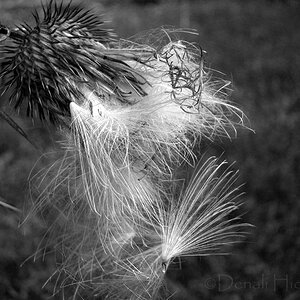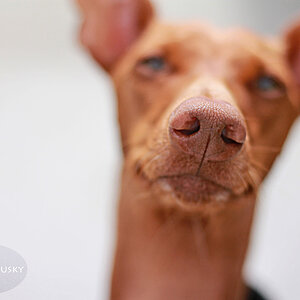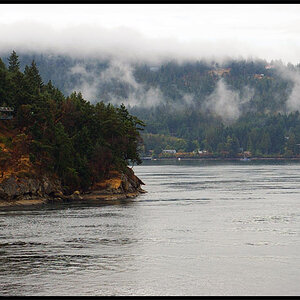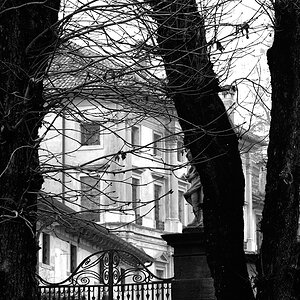pgriz
Been spending a lot of time on here!
- Joined
- Jul 30, 2010
- Messages
- 6,734
- Reaction score
- 3,221
- Location
- Canada
- Can others edit my Photos
- Photos OK to edit
Warning... long post.
Lets try an experiment. Same photographer (you). Same equipment (yours). Well compare taking a quickie shot and the result of the same scene shot by design. Required tool: a good tripod.
Since most of the scenes and images we shoot are relatively static, lets start with a static scene. It can be indoors or outside. It can be a table arrangement that you like, a plant, a piece of furniture, a room in your house, a person sitting or lying down, a cooperative pet. Or it can be your yard, a tree, or something else outside thats not running about or jumping all over, or moving with some speed.
The experiment is to find that scene we like and shoot it snapshot-style (ie, with minimal thought or preparation), and then go to the process of constructing a shot (the deliberate act) of the same object or scene, and comparing them to see if the extra effort was worth the results.
So, pick your scene/object and take the first shot.
Now, lets step back, put aside the camera and look at your chosen scene or object. What was it about it that made you want to shoot it? Was it colour? A colour contrast? Shape? Texture? An interesting lighting effect? A geometric arrangement? A story? A humorous contrast?
What elements of this scene/object would you want to emphasize to make for an interesting story or image? What emotions would you want to evoke for the viewer of the scene?
What is the relation of the scene/object to its surroundings? Is this relationship part of the storey, or is it irrelevant and distracting? If relevant, how to express the context and give meaning to the relation between the scene/object and the surrounding foreground/background? If NOT relevant, how to isolate the scene/object so that the foreground/background do not intrude or distract?
What type of light would be best for showing the best aspects of the scene/object, in the way that contributes to the mood or emotion youre trying to convey? Would it be an overall, diffuse soft light (few or no shadows), or a more directional light (with medium to strong shadows)? If directional, from which angle? Should the resulting shadows be left alone, or should they be softened by a fill light? If so, from which angle, and with what proportion to the main light?
OK.
So far, youve chosen a scene/object, figured out which characteristics were appealing to you, decided whether or not the scene/object is to be shown with the surroundings, or isolated from the surroundings, and thought about how the light source and direction would enhance the vision that you have had.
Now, lets look at angles of view and perspective. Chances are, you shot the original photo at eye level. Thats from where most casual photos are taken. But for this scene/object, is this the best point of view? How would one from the floor/ground look? How about getting up on a ladder and looking down? What about from a different angle? If youre trying to place the scene/object in context, is there something you can place in the foreground that would really make it clear what the relationship is? Is there an angle with which you can include more of the background, if it is relevant? If, on the other hand, the foreground/background are irrelevant and distracting, what angle of view would best eliminate them as distracting intruders?
In terms of perspective, is showing depth important to this scene/object? If so, which method of showing depth would be most effective in this situation? Converging lines? Graduated shadows? Selective focus?
What about the distance of the viewer from the scene/object? Do you want them to feel in or close to the scene/object, or do you want them to have some visual distance? Which viewpoint would contribute best to the story or image youre creating?
Now, weve also figured out the best angle, the amount of perspective, and the approximate distance of the viewer to the scene/object. Time to get technical.
Get your camera, put it on a tripod, and position the camera at the approximate angle and distance youve decided is the best for this scene/object. Next to decide: which focal length to use?
The focal length affects the angle of view and the depth of field. As the focal length goes down, the angle of view increases as does the depth of field. So, if your goal is to show the scene/object in relation to its surroundings AND with the foreground and background in sharp focus, then most likely youd choose a wide angle focal length to give you the depth of field to allow that. Of course, depth-of-field is also related to aperture, so you have both focal length and aperture as tools to enable you to achieve the target depth-of-field. If youre trying to isolate the scene/object from its surroundings, then you would probably go to the normal or telephoto focal lengths, as the angle of view decreases and so does the depth-of-field. So choose a focal length that gives you the right framing (angle) of the scene/object, and also accommodates the depth of field you need.
Frame the image at the chosen focal length and decide where the scene/object should be placed in the frame to give the most pleasing view? Centered? Yes, if were trying to emphasize symmetry. If not, following the guideline of the rule-of-thirds may be more appropriate? What about orientation? Is the scene/object more vertical or horizontal? Which orientation (landscape/portrait) would best accommodate and fit the scene/object? With your orientation chosen, recompose.
Where should you place the focus point? The narrower the depth-of-field, the more critical the placement of the focal point becomes. Is sharpness essential to conveying the image that youre trying to create? If so, which part of the image MUST be in sharp focus? Chances are, your cameras autofocus is NOT on that part. So switch your AF off and focus manually. If you have live-view, use this aid to magnify the point on which you are focusing to ensure the best focus.
Next, do you have enough depth-of-field to include all the scene/object that you want to include? This is a function of the aperture. Most cameras show the view at the wide-open aperture, and only snap to the correct chosen aperture at exposure. There is usually a button which allows you to see the stopped down aperture in the viewfinder. Use it to determine if the near and far points of your scene that NEED to be in focus ARE in focus. If not, increase the aperture. On the other hand, if you are trying to isolate your scene/object from foreground and background, you will want to reduce your depth-of-field by opening the aperture. Another way of determining the correct aperture to use is to refer to a calculator such as on www.dofmaster.com, which allows you to calculate this.
Before we deal with exposure, we have to deal with ISO. The lowest noise, best colour balance and color saturation is at the native ISO setting for a camera. For Canons this is ISO 100, and for Nikons this is ISO 200. Use these settings unless you have a VERY good reason to change them. In any case, your cameras on a tripod, so you can go to very slow shutter speeds without blurring.
Other camera settings: for the most flexibility, shoot in RAW if your camera supports it. These files require post-processing to generate usable images, but you get so much more flexibility and ability to correct mistakes, that it is well worth mastering. If youre kinda lazy, many cameras can shoot both RAW and high-definition JPEG in the same shot. Then you can get the quick benefits of JPG files, while still having the RAW image to play with later, if you so need.
Colour balance. Depends on what your primary light source is, and also on your personal preference. Most cameras give you the choices of Daylight, Cloudy, Shade, Fluorescent, Incandescent, Flash, and AUTO. Pick the option that is closest to the primary light source of your scene/object. If the colour balance is somewhat off, you can correct it in post-processing of your RAW files. Too bad if you only have JPG, as the colour balance is locked in in that format.
Finally we can set the exposure. Ummmm. Not so fast. What is the brightness variation across your image? If its evenly lit with minimal or no shadows, AND the primary scene/object is not naturally very dark or very light, then the standard exposure will probably work well. If not, youll have to use the meter reading as a starting point, and make adjustments. All camera meters are calibrated to give you a correct exposure when the scene averages 18% grey. But if your scene is lighter or darker than average, youll have to compensate manually.
Digital cameras have a dynamic range of 8-10 stops (depending on the camera), and if the scene youre shooting has elements that are more than 8-10 stops different in brightness, then you will have to decide whether to let the bright parts blow out (no detail) to preserve some shadow detail, or let the shadow detail block up (no detail) to preserve the highlight detail. A good approach to verifying the dynamic range of the scene is to take an average reading of the overall scene, then with the spot-meter option, read the exposure for the brightest and the darkest elements. Lets say the average exposure was 1/60 at f/11. The brightest element measured at 1/1000 at f/11 and the darkest was at 1/8 at f/11. So the brightest element was 5 stops above the average, and the darkest element was at 4 stops below the average. If the brightest element had detail that was important to the scene/object, then youd want to bias your exposure upwards, so that the bright elements are within 4 stops of the exposure. This means that your initial exposure of 1/60 at f/11 should be changed to 1/125 at f/11. This will make the overall picture darker by one stop, but will allow you to preserve the highlight detail.
OK. Take the second shot.
Compare the two. Which one gives you a better result?
For those who think this is too much work Good and experienced photographers internalize this process so its automatic. Experience and practice should allow the technical stuff to be done in under a minute. Set the camera up, choose the lens, set the focal length, take the meter readings, set the exposure, check the focus point, DOF, extraneous materials click.
There is a pile of stuff that I didnt cover in this little experiment, but my goal here isnt to give a complete course on photography in one post, but to get people, especially beginners, to think about the images they are creating, and the process they can use to make the decisions. Im sure the pros on this forum will be able to correct my little exposition in many ways, and suggest other improvements.
So any takers?
Lets try an experiment. Same photographer (you). Same equipment (yours). Well compare taking a quickie shot and the result of the same scene shot by design. Required tool: a good tripod.
Since most of the scenes and images we shoot are relatively static, lets start with a static scene. It can be indoors or outside. It can be a table arrangement that you like, a plant, a piece of furniture, a room in your house, a person sitting or lying down, a cooperative pet. Or it can be your yard, a tree, or something else outside thats not running about or jumping all over, or moving with some speed.
The experiment is to find that scene we like and shoot it snapshot-style (ie, with minimal thought or preparation), and then go to the process of constructing a shot (the deliberate act) of the same object or scene, and comparing them to see if the extra effort was worth the results.
So, pick your scene/object and take the first shot.
Now, lets step back, put aside the camera and look at your chosen scene or object. What was it about it that made you want to shoot it? Was it colour? A colour contrast? Shape? Texture? An interesting lighting effect? A geometric arrangement? A story? A humorous contrast?
What elements of this scene/object would you want to emphasize to make for an interesting story or image? What emotions would you want to evoke for the viewer of the scene?
What is the relation of the scene/object to its surroundings? Is this relationship part of the storey, or is it irrelevant and distracting? If relevant, how to express the context and give meaning to the relation between the scene/object and the surrounding foreground/background? If NOT relevant, how to isolate the scene/object so that the foreground/background do not intrude or distract?
What type of light would be best for showing the best aspects of the scene/object, in the way that contributes to the mood or emotion youre trying to convey? Would it be an overall, diffuse soft light (few or no shadows), or a more directional light (with medium to strong shadows)? If directional, from which angle? Should the resulting shadows be left alone, or should they be softened by a fill light? If so, from which angle, and with what proportion to the main light?
OK.
So far, youve chosen a scene/object, figured out which characteristics were appealing to you, decided whether or not the scene/object is to be shown with the surroundings, or isolated from the surroundings, and thought about how the light source and direction would enhance the vision that you have had.
Now, lets look at angles of view and perspective. Chances are, you shot the original photo at eye level. Thats from where most casual photos are taken. But for this scene/object, is this the best point of view? How would one from the floor/ground look? How about getting up on a ladder and looking down? What about from a different angle? If youre trying to place the scene/object in context, is there something you can place in the foreground that would really make it clear what the relationship is? Is there an angle with which you can include more of the background, if it is relevant? If, on the other hand, the foreground/background are irrelevant and distracting, what angle of view would best eliminate them as distracting intruders?
In terms of perspective, is showing depth important to this scene/object? If so, which method of showing depth would be most effective in this situation? Converging lines? Graduated shadows? Selective focus?
What about the distance of the viewer from the scene/object? Do you want them to feel in or close to the scene/object, or do you want them to have some visual distance? Which viewpoint would contribute best to the story or image youre creating?
Now, weve also figured out the best angle, the amount of perspective, and the approximate distance of the viewer to the scene/object. Time to get technical.
Get your camera, put it on a tripod, and position the camera at the approximate angle and distance youve decided is the best for this scene/object. Next to decide: which focal length to use?
The focal length affects the angle of view and the depth of field. As the focal length goes down, the angle of view increases as does the depth of field. So, if your goal is to show the scene/object in relation to its surroundings AND with the foreground and background in sharp focus, then most likely youd choose a wide angle focal length to give you the depth of field to allow that. Of course, depth-of-field is also related to aperture, so you have both focal length and aperture as tools to enable you to achieve the target depth-of-field. If youre trying to isolate the scene/object from its surroundings, then you would probably go to the normal or telephoto focal lengths, as the angle of view decreases and so does the depth-of-field. So choose a focal length that gives you the right framing (angle) of the scene/object, and also accommodates the depth of field you need.
Frame the image at the chosen focal length and decide where the scene/object should be placed in the frame to give the most pleasing view? Centered? Yes, if were trying to emphasize symmetry. If not, following the guideline of the rule-of-thirds may be more appropriate? What about orientation? Is the scene/object more vertical or horizontal? Which orientation (landscape/portrait) would best accommodate and fit the scene/object? With your orientation chosen, recompose.
Where should you place the focus point? The narrower the depth-of-field, the more critical the placement of the focal point becomes. Is sharpness essential to conveying the image that youre trying to create? If so, which part of the image MUST be in sharp focus? Chances are, your cameras autofocus is NOT on that part. So switch your AF off and focus manually. If you have live-view, use this aid to magnify the point on which you are focusing to ensure the best focus.
Next, do you have enough depth-of-field to include all the scene/object that you want to include? This is a function of the aperture. Most cameras show the view at the wide-open aperture, and only snap to the correct chosen aperture at exposure. There is usually a button which allows you to see the stopped down aperture in the viewfinder. Use it to determine if the near and far points of your scene that NEED to be in focus ARE in focus. If not, increase the aperture. On the other hand, if you are trying to isolate your scene/object from foreground and background, you will want to reduce your depth-of-field by opening the aperture. Another way of determining the correct aperture to use is to refer to a calculator such as on www.dofmaster.com, which allows you to calculate this.
Before we deal with exposure, we have to deal with ISO. The lowest noise, best colour balance and color saturation is at the native ISO setting for a camera. For Canons this is ISO 100, and for Nikons this is ISO 200. Use these settings unless you have a VERY good reason to change them. In any case, your cameras on a tripod, so you can go to very slow shutter speeds without blurring.
Other camera settings: for the most flexibility, shoot in RAW if your camera supports it. These files require post-processing to generate usable images, but you get so much more flexibility and ability to correct mistakes, that it is well worth mastering. If youre kinda lazy, many cameras can shoot both RAW and high-definition JPEG in the same shot. Then you can get the quick benefits of JPG files, while still having the RAW image to play with later, if you so need.
Colour balance. Depends on what your primary light source is, and also on your personal preference. Most cameras give you the choices of Daylight, Cloudy, Shade, Fluorescent, Incandescent, Flash, and AUTO. Pick the option that is closest to the primary light source of your scene/object. If the colour balance is somewhat off, you can correct it in post-processing of your RAW files. Too bad if you only have JPG, as the colour balance is locked in in that format.
Finally we can set the exposure. Ummmm. Not so fast. What is the brightness variation across your image? If its evenly lit with minimal or no shadows, AND the primary scene/object is not naturally very dark or very light, then the standard exposure will probably work well. If not, youll have to use the meter reading as a starting point, and make adjustments. All camera meters are calibrated to give you a correct exposure when the scene averages 18% grey. But if your scene is lighter or darker than average, youll have to compensate manually.
Digital cameras have a dynamic range of 8-10 stops (depending on the camera), and if the scene youre shooting has elements that are more than 8-10 stops different in brightness, then you will have to decide whether to let the bright parts blow out (no detail) to preserve some shadow detail, or let the shadow detail block up (no detail) to preserve the highlight detail. A good approach to verifying the dynamic range of the scene is to take an average reading of the overall scene, then with the spot-meter option, read the exposure for the brightest and the darkest elements. Lets say the average exposure was 1/60 at f/11. The brightest element measured at 1/1000 at f/11 and the darkest was at 1/8 at f/11. So the brightest element was 5 stops above the average, and the darkest element was at 4 stops below the average. If the brightest element had detail that was important to the scene/object, then youd want to bias your exposure upwards, so that the bright elements are within 4 stops of the exposure. This means that your initial exposure of 1/60 at f/11 should be changed to 1/125 at f/11. This will make the overall picture darker by one stop, but will allow you to preserve the highlight detail.
OK. Take the second shot.
Compare the two. Which one gives you a better result?
For those who think this is too much work Good and experienced photographers internalize this process so its automatic. Experience and practice should allow the technical stuff to be done in under a minute. Set the camera up, choose the lens, set the focal length, take the meter readings, set the exposure, check the focus point, DOF, extraneous materials click.
There is a pile of stuff that I didnt cover in this little experiment, but my goal here isnt to give a complete course on photography in one post, but to get people, especially beginners, to think about the images they are creating, and the process they can use to make the decisions. Im sure the pros on this forum will be able to correct my little exposition in many ways, and suggest other improvements.
So any takers?





![[No title]](/data/xfmg/thumbnail/42/42481-e35ff0c514a554d7bd4381fb2ae79c5a.jpg?1619740195)
![[No title]](/data/xfmg/thumbnail/37/37520-d3e4d6582aa2781be7abf64e8651db45.jpg?1619738128)
![[No title]](/data/xfmg/thumbnail/42/42480-70a0d1b3ccdeb380098dd12f512b4a17.jpg?1619740195)
![[No title]](/data/xfmg/thumbnail/35/35932-28690c4fc247cf491230e47fc70ebeb5.jpg?1619737235)
![[No title]](/data/xfmg/thumbnail/42/42479-eb9612f7aa37a41755b9e23b5739a3bf.jpg?1619740195)
![[No title]](/data/xfmg/thumbnail/35/35931-5e10675f3f7d827bc7ae4689f16bda8a.jpg?1619737234)
![[No title]](/data/xfmg/thumbnail/36/36662-242aa39f5cb3a23494857864779f669b.jpg?1619737675)




